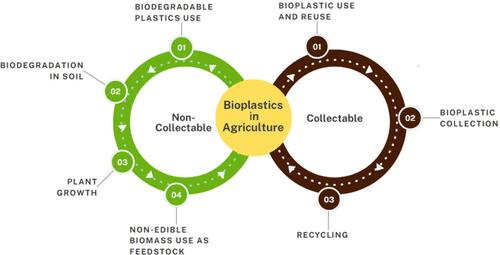Embracing Nature’s Clockwork: Crafting Plastics for Degradation in Plant Agricultural Systems
IF 5.7
Q2 CHEMISTRY, PHYSICAL
引用次数: 0
Abstract
In the 21st century, global agriculture confronts the urgent challenge of increasing food production by 70% by 2050 while simultaneously addressing environmental and health concerns. Plastics, integral to agricultural innovation, present sustainability challenges due to their non-biodegradable nature and contribution to pollution. This perspective examines the transition to bioplastics, emphasizing their bio-based origin and their crucial characteristic of being readily biodegradable in the soil. Key bioplastics such as poly(lactic acid) (PLA), polyhydroxyalkanoates (PHAs), and biomass-derived polymers are discussed, particularly regarding the microplastic generation in soil resulting from their use in specific applications like mulch films, delivery systems, and soil conditioners. Embracing bioplastics signifies a significant step forward in achieving sustainable agriculture and addressing plastic waste. However, it is highlighted that while some bioplastics can be recovered and recycled, special applications where the plastic is in intimate contact with soil pose challenges for recovery. In these cases, that represent more than the 50% of plastics used in agriculture, meticulous design for biodegradation in soil synchronized with agricultural cycles is necessary. This approach ensures minimal environmental impact and promotes a circular approach to plastic use in agriculture.

拥抱大自然的发条:在植物农业系统中制作降解塑料
21 世纪,全球农业面临着到 2050 年将粮食产量提高 70%,同时解决环境和健康问题的紧迫挑战。塑料是农业创新不可或缺的一部分,但由于其不可生物降解的特性和造成污染的原因,给可持续发展带来了挑战。本视角探讨了向生物塑料过渡的问题,强调了生物塑料的生物基来源及其在土壤中易于生物降解的重要特性。本文讨论了聚乳酸(PLA)、聚羟基烷酸酯(PHAs)和生物质衍生聚合物等主要生物塑料,特别是它们在地膜、输送系统和土壤改良剂等特定应用中使用时在土壤中产生的微塑料。采用生物塑料标志着在实现可持续农业和解决塑料废弃物方面迈出了重要一步。不过,需要强调的是,虽然有些生物塑料可以回收和再循环,但塑料与土壤亲密接触的特殊应用给回收带来了挑战。在这些情况下(占农业塑料用量的 50%以上),有必要进行精心设计,使其在土壤中的生物降解与农业周期同步。这种方法可确保对环境的影响降到最低,并促进塑料在农业中的循环使用。
本文章由计算机程序翻译,如有差异,请以英文原文为准。
求助全文
约1分钟内获得全文
求助全文
来源期刊

ACS Materials Au
材料科学-
CiteScore
5.00
自引率
0.00%
发文量
0
期刊介绍:
ACS Materials Au is an open access journal publishing letters articles reviews and perspectives describing high-quality research at the forefront of fundamental and applied research and at the interface between materials and other disciplines such as chemistry engineering and biology. Papers that showcase multidisciplinary and innovative materials research addressing global challenges are especially welcome. Areas of interest include but are not limited to:Design synthesis characterization and evaluation of forefront and emerging materialsUnderstanding structure property performance relationships and their underlying mechanismsDevelopment of materials for energy environmental biomedical electronic and catalytic applications
 求助内容:
求助内容: 应助结果提醒方式:
应助结果提醒方式:


